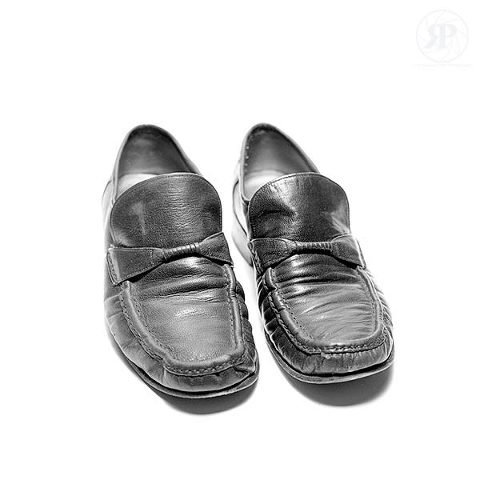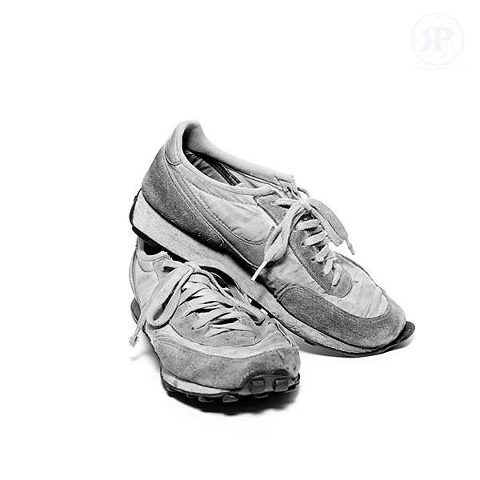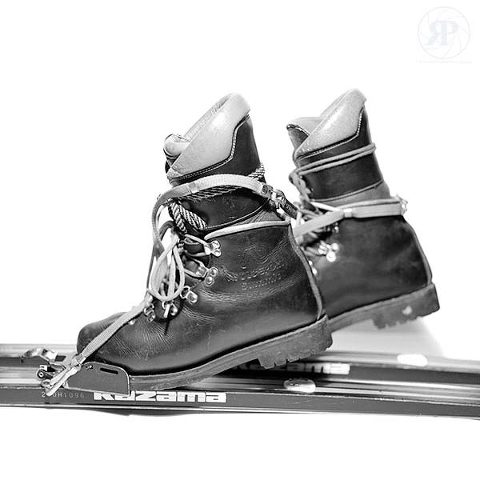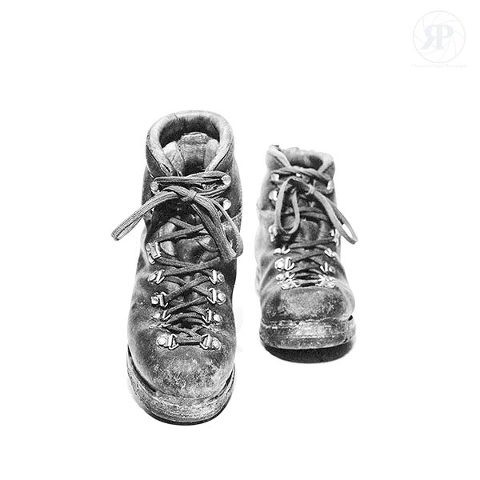More subterranean diving in the filing cabinets — in the “Odds & Sods” subfolder — has turned up this self-assigned exercise in tabletop photography, from 1983.
At the time, I was working for Mountain Equipment Co-op, as a salesperson, warrantee rep, and catalogue photographer. Though I’d been shooting outdoor clothing on location, a move into technical gear (everything from climbing hardwear to camp stoves) required more serious study of studio lighting.
My studio consisted of a small basement room in Vancouver, B.C. Lighting: a couple of tungsten floodlights, aided by paper reflectors.
My technique, as such, was influenced not so much by other catalogue photography as it was by still life studies by photographers such as Irving Penn, whose photographs of discarded cigarette butts I’d recently seen.
Following on from my first test of a newly-aquired Mamixaflex medium-format camera and Zone System exposure, I recorded the experiment in detail, including lighting and reflector positions, lighting modifiers, film-plane-to-subject distance, and exposure information.
What began as a session with my cycling gloves soon turned into a boot shoot when I realized I had more footwear and they were more interesting, especially the most well-worn exhibits.
.jpg)
I chose slow (50ASA), fine-grain Ilford Pan F film, rated at 40, to be developed in Perceptol for 18 minutes. I knew this combination would result in very sharp, grainless negatives with an unsurpassed tonal range … if I got everything right. For the most part, I did. You can see that on the second roll, I began with an exposure of ⅒ sec @ f/4 for the hiking boots (Galibier Vercors) — a perfect exposure — while the next two shots turned out to be underexposed. I presume that the notes “blew these two” and “somewhere f.11 or 8” were added after development and contact sheet examination.
The successful first exposure lacked sufficient depth-of-field (though I wasn’t looking for total front-to-back focus) while the following frames were underexposed — “blown” perhaps by failure to compensate for the smaller f-stop with longer exposure time (probably should have been ½-1 second, going on other exposures). The underexposure, of course, undermined Pan F’s superior grain structure.
Yet, aside from the first well-exposed glove photo, printed on the lovely old warm-tone Kodak Ektalure portrait paper, none of these images made it to the print stage … until now.
Last week, I scanned selected negatives and subjected them to various post-processing tools, including Photoshop and Nik software, for the most part, but for basic restoration, avoiding manipulations I could not have achieved with traditional darkroom technology.
So far, I’ve printed them (with the Epson 4900) on lustre paper with neutral monotone profile and on Hahnemühle matte paper, which results in a very warm tone (reminiscent, in tone if not surface, of the Ektalure) that I’m rather partial to.
Though 33-years have elapsed since I made these images, I believe I’ve honoured the original intent: high-key*, graphic representations of everyday (though somewhat specialized) objects removed from their workaday environment, yet defined by the patina that speaks of their use — though this goes without saying, if the photos speak for themselves.
*In the notes (above), I recorded that the background “falls on Zone 8 or above,” 3-stops or more beyond the “lightest part of leather” (Zone 5).
Footnotes
- Loafers: While hipper colleagues wore winkle-pickers from Fox and Fluevog, I danced Vancouver’s nightclubs (The Love Affair, Graceland) in these recycled shoes.
- Ice Climbing Boots & Crampons: These represented the first examples of now common plastic shell mountaineering boots. I suffered blistered shins to test them on an expedition into the northern Coast Range of British Columbia.
- Running Shoes: As I recall, these were trail running shoes. I ran trails in them.
- “EB” (Edouard Bourdonneau) Rock Climbing Shoes: These popular kletterschuhes represented the first big advance in technical rock climbing footwear. I stitched leather over the fragile canvas uppers. Typically, one wore them at least 2-sizes smaller than normal footwear, better to feel every pimple and dimple in the rock. What’s an ingrown toenail when records, and/or one’s life, are at stake?
- Detto Pietro Cycling Shoes: Ah, the days of nail-on cleats, toe-clips, straps and handmade Italian cycling shoes.
- Big Wall Boots: If you were determined to hang out on vertical cliffs standing in etriérs (ladders fashioned from nylon webbing), the stiff insole in these boots would at least stave off instep cramps, if not brain spasms.
- Telemark Boots & Skis: In 1980, this was the premier telemark skiing kit. This particular boot combo was created by substituting stiffer ski-mountaineering inner-boots for the stock insulated liners in the Asolosport “Summit” cross-country boot, which had had its steel, three-pin-binding toe-insert reinforced by a skiing cobbler, in Seattle. This enabled lighter, cross-country-downhill skis to be used, with appropriate skills, on winter mountaineering expeditions, in place of heavy ski-mountaineering equipment. This prototype, tested on the “Separation Pay Traverse,” was later marketed as “Frank’s Ski Boot,” by MEC.
- Galibier Vercors: Incredibly heavy by today’s standards, these weathered specimens represent the world-class French “lightweight” mountaineering boot of the day. They took me to many great viewpoints.



















